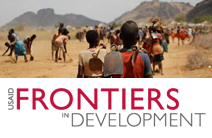- Agriculture and Food Security
- Democracy, Human Rights and Governance
- Economic Growth and Trade
- Education
- Environment and Global Climate Change
- Frontiers in Development
- Gender Equality and Women's Empowerment
- Global Health
- Science, Technology and Innovation
- Water and Sanitation
- Working in Crises and Conflict
- Responding in Times of Crisis
- Crises and Conflict Countries
- How We Do It
- Where We Work
- Afghanistan
- Benin
- Bosnia and Herzegovina
- Bulgaria
- Burkina Faso
- Burma
- Cambodia
- Cameroon
- Central African Republic
- Chad
- China
- Comoros
- Côte d’Ivoire
- Democratic Republic of the Congo
- Ecuador
- El Salvador
- Ethiopia
- Fiji
- Ghana
- Guatemala
- Haiti
- Honduras
- Horn of Africa
- India
- Indonesia
- Kenya
- Lesotho
- Liberia
- Madagascar
- Malawi
- Mali
- Mauritania
- Montenegro
- Mozambique
- Niger
- Pakistan
- Papua New Guinea
- Paraguay
- Philippines
- Republic of the Congo
- Senegal
- Somalia
- South Sudan
- Sri Lanka
- Sudan
- Syria
- Tanzania
- Thailand
- The Gambia
- The Sahel
- Tunisia
- Turkey
- Tuvalu
- Vietnam
- Yemen
- Why It Matters
- How To Help
- Resources
- Building Resilience
- Conflict Mitigation and Prevention
- Disaster Risk Reduction
- Peacebuilding and Reconciliation
- Promoting Peaceful Political Transitions
- Providing Safe & Secure Environments for Development
- Recovering From Crisis
- World Humanitarian Day
- Responding in Times of Crisis
Ethiopia

Consecutive seasons of failed rains combined with rapid population growth, above-average food prices, localized conflict, and endemic poverty contribute to an ongoing complex emergency in Ethiopia. In 2011, drought conditions resulting from La Niña weather patterns resulted in severe water shortages throughout the country. In addition to below-normal harvests, failed rains resulted in pasture and water shortages for livestock. In 2012, the near-complete failure of the February-to-May 2012 belg harvest, along with acute water shortages, has resulted in persistent food insecurity and malnutrition in southern Ethiopia. Localized inter-communal violence and seasonal flooding have exacerbated humanitarian conditions in drought-affected areas in recent months. As of August 23, the U.S. Government (USG) had provided more than $241.4 million to support humanitarian activities in Ethiopia in Fiscal Year (FY) 2012.
USG HUMANITARIAN FUNDING PROVIDED IN FY 2012
|
USAID/OFDA Assistance to Ethiopia |
$26,579,173* |
|
USAID/FFP Assistance to Ethiopia |
$181,774,100 |
|
State/PRM Assistance to Ethiopia |
$33,050,262 |
|
Total USAID and State Assistance |
$241,403,535 |
*This figure includes funding for both disaster response and disaster risk reduction activities. (As of August 23, 2012)
Latest Ethiopia Fact Sheet
Horn of Africa Fact Sheet #28 (422kb PDF) and map (1.41mb PDF)
Key Developments
On August 13, the Government of Ethiopia (GoE) released the revised July-to-December 2012 Humanitarian Requirements Document (HRD). The revised HRD estimates that nearly 3.76 million people will require relief food assistance for the remainder of 2012, an increase of nearly 16 percent over the January-to-June caseload of approximately 3.2 million individuals. The revised HRD also indicates that approximately 2.25 million people across Ethiopia will require emergency health and nutrition assistance during the second half of 2012, including an estimated 146,000 children under the age of five at risk of severe acute malnutrition. In addition, the revised HRD estimates that 1.2 million pastoral and agro-pastoral households will require agriculture and food security assistance in the coming months. USAID’s Office of U.S. Foreign Disaster Assistance (USAID/OFDA) continues to support nine partners to implement agriculture and food security, health, and nutrition activities in drought- and flood-affected areas across Ethiopia.
As of late July, intercommunal conflict in southern Ethiopia’s Moyale District and surrounding areas had displaced more than 46,000 people within Ethiopia, including nearly 34,000 people in Oromiya Region and more than 12,000 individuals in Somali Region, according to a recent GoE assessment that also indicated that displaced populations require food assistance and emergency relief supplies. The U.N. World Food Program and the International Organization for Migration plan to respond to the affected populations’ humanitarian needs for food assistance and emergency relief supplies.
@theOFDA
-
theOFDA
MT @USAID: We are the largest provider of in-kind food aid + one of largest providers of cash-based food asst in the world. #WFD2012
5 hours 5 min ago.
-
theOFDA
RT @UNICEF: Did you know handwashing with soap is the single most cost-effective health intervention ever? #iwashmyhands Please RT!
4 days 12 hours ago.
-
theOFDA
Women and Girls Reduce Disaster Risk Every Day t.co/ZGNjnYIf #IDDR
4 days 16 hours ago.








Comment
Make a general inquiry or suggest an improvement.